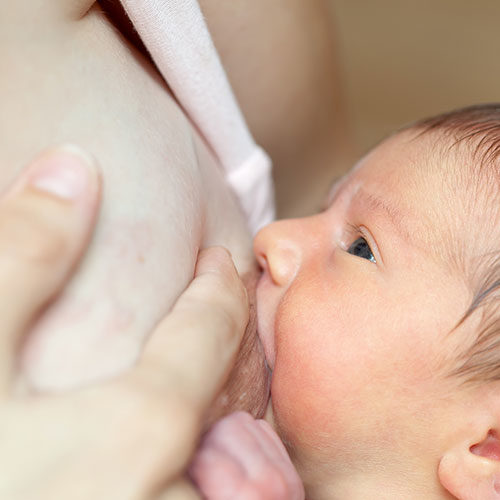- Mothers who give birth through c-section cannot produce milk immediately.
Milk production begins during pregnancy. Thus, a mother will have milk for her baby upon birth irrespective of the type of birth. - Mothers who give birth to multiples almost never produce enough milk for both (or all) of her babies.
Milk production works on a demand and supply basis. More the demand, more the supply. Therefore, it is absolutely possible to make enough milk for multiple babies. - Mother should stop breastfeeding if she is unwell.
The antibodies that the mother’s body produces in order to fight the infection off can be passed onto the baby via breast milk. Considering this, it becomes even more vital and essential for the mother to continue her baby through her own illness. The antibodies that the baby gets via breast milk protects the baby against the infection. - One breast produces food (fatty milk) and the other produces water (watery milk); therefore mothers should switch breasts often while nursing to provide the baby both.
Each breast produces watery milk (foremilk – produced early on in a nursing session that quenches the baby’s thirst) and fatty milk (hindmilk – produced towards the end of a nursing session that satisfies the baby’s hunger and plays a crucial part in the baby’s weight gain). However, these are not two different types of milk. There is no magic point where the foremilk turns into hindmilk. They run along a continuum. Thus, it is important to let the baby drain a breast fully (in order to get both foremilk and hindmilk) before switching to another breast. - Whenever the baby cries, it’s because of hunger.
Crying is the only tool of communication a newborn has. It could mean many things like feeling hot/cold, need for a nappy change, gas, an uncomfortable position, need for warmth and security, need to be near the mother, overall discomfort etc. - Baby will cry if she is hungry.
Crying is a very late cue of hunger. A newborn baby displays early hunger cues like looking around, opening mouth, smacking lips, bringing hands to mouth etc. Sometimes these early hunger cues are followed by going back to sleep, without crying. So, it’s not always necessary that the baby will cry if she is hungry. It is important to pick up on early hunger cues to feed the baby and not wait for the baby to cry. - A mother with small breasts produces less milk.
The capacity to produce milk is based on the breast tissues that contain milk ducts. These are different from the fatty tissues that determine the size of the breast. Thus, no matter the size of the breasts, a mother will produce enough milk for her baby if the baby is nursed on demand. - Breastfeeding causes the breasts to sag.
Sagging is a side-effect of pregnancy and not breastfeeding. In fact, the longer the duration of breastfeeding, the better are the chances for the breasts to sag less. - Top milk must be introduced after the baby turns 6 months old.
A mother will continue to produce enough milk for the baby no matter the baby’s age if nursed on demand. If solids are introduced in a gradual manner, considering breast milk remains the main source of nutrition for a baby until she turns 1 year old, the mother’s supply will not take a hit and there will be no need to introduce top milk. - It is important to consume milk to make enough milk.
Mother’s milk consumption has nothing to do with her milk production. Milk is made from blood cells. A healthy, balanced and complete diet ensures enough milk production. - A sleeping baby should not be woken up, even to breastfeed.
Until the baby has regained her birth weight, it is vital to nurse the baby every 1.5 to 2 hours or on demand – whichever is earlier. It is important, therefore, to wake up a sleeping baby and nurse her at regular intervals.






